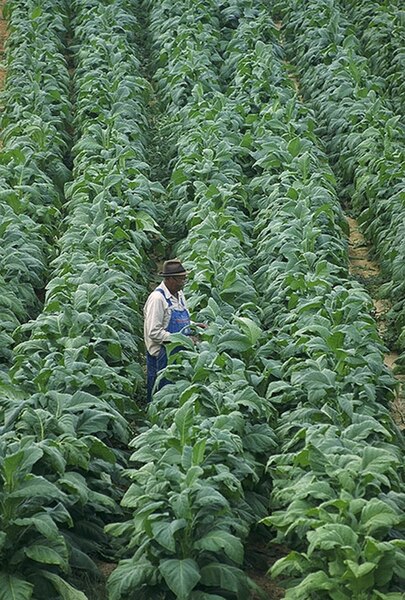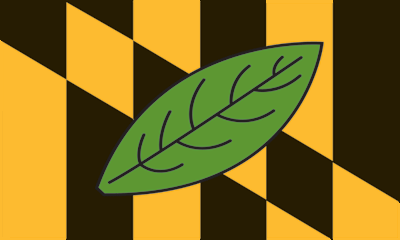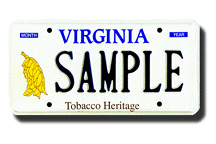
A field of cultivated Tobacco in Chatham, Pittsylvania County, Virginia.
We might note that several species of Tobacco are grown commercially, with two most notable -- Nicotiana tabacum is certainly the most common, and is typically what folks are referring to when they say Tobacco. Interestingly, N. rustica, which was the originally cultivated species in Virginia, and much more potent in nicotine, is now popular in Asia. This site has an interesting set of information on these species: http://artsci.wustl.edu/~gjfritz/Nicotiana_sp.html

This map shows the primary areas of Tobacco production worldwide.
Today, China, India, and Brazil all produce more Tobacco than the United States. In the United States, North Carolina and Kentucky are now the leaders in production, while in Virginia, production is concentrated in the Southside of Virginia (the south-central area). The Tidewater, formerly an area of production, has long sense moved away from its production. Still, reminders of its former place there remain in such things as the seal of Prince William County, Virginia and the flag of nearby Calvert County, Maryland.

The Seal of Prince William County, Virginia, with its prominent display of a Tobacco plant.

The flag of nearby Calvert County, Maryland, with a Tobacco leaf over the Calvert family crest.
Returning to the historical situation in colnial Virginia, Tobacco was the cash crop that finally gave a new colony of Virginia its economically viable reason for existing. Precious metals were not found here as they had been in Mexico and Peru, and Virginia was too far north for crops such as sugar. So it was that Tobacco was struck upon as a cash crop that would grow, and would almost embody the economy of Virginia for several centuries. It would continue to have an important role in the agriculture of Virginia for quite some time even after the Revolution.
In addition, the cultivation of Tobacco resulted in a unique and rural society in the Old Dominion.
"Thomas Jefferson noted in 1785 that, “[o]ur country being much intersected with navigable waters, and trade brought generally to our doors, instead of our being obliged to go in quest of it, has probably been one of the causes why we have no towns of any consequence.”[1] As Jefferson observed, part of the reason behind this aversion to all things urban was the tendency of the widely scattered planters to trade directly with England for her goods. These farmers traded directly with their mother country because, primarily, of the nature of the crop that they grew: tobacco. It was tobacco that Virginia grew above all else so that “[b]y the middle of the eighteenth century, many people both in the colonies and the mother country had come to regard Virginia and tobacco as synonymous.”[2] The Virginia farmer could to grow tobacco on a particular field for some three years before depleting the soil. He would then plant the field with corn for up to ten years, and he then “abandoned the field, allowing it to revert to pine forest.”[3] This was anything but the kind of farming known in England, for the farmer in the Old Dominion[4] rarely used the plough, never used manure, and would usually till the ground with hoes alone.[5] This reckless manner of cultivation demanded much land, for the tobacco farmer was always in need of fresh soil. This need of land was one major contributing factor to the scattered nature of Virginia’s citizens. The other was the tobacco driven economy. Tobacco was essentially the currency in the colony, for coins were rare in Virginia, and tobacco was used to pay for everything. Even the royal governor of Virginia taxed in it.[6] The majority of this cash crop would be shipped to England, and, in return, the goods desired would be shipped back over to the planters in the Old Dominion. The farmers themselves grew enough food to subsist, and so they gained all of their other wants by means of the tobacco shipped to England. There was simply no reason to congregate in towns when there is no money, and no market for anything but tobacco to be sent to England. Thus, Virginia was deprived not only of towns themselves, but the whole class of tradesmen that would normally be associated with the urban economy. This was the economic and social arrangement that would remain dominant throughout Virginia’s years as a colony.
[1] Thomas Jefferson, Notes on the State of Virginia, ed.
Frank Shuffelton (Paris: 1785; reprint, New York: Penguin Books, 1999), 114.
Query XII.
[2] T.H. Breen, Tobacco Culture (Princeton, New Jersey:
Princeton University Press, 1985), 57.
[3] William
Hemphill et al., Cavalier Commonwealth
(New York: McGraw Hill Book Company, Ltd., 1957), 49.
[4] King Charles II, following
his restoration to the English throne in 1660, granted the title of “Old
Dominion” to the colony of Virginia.
This name of endearment was given in gratitude for Virginia’s loyalty to
the Stuarts during the English Civil War.
[5] Charles
Campbell, History of the Colony and
Ancient Dominion of Virginia (Philadelphia: J.B. Lippincott and Co., 1860), 349.
[6] Ibid., 350."
So it was Tobacco that prevented Virginia, the most populated of the original 13 states, from having any urban area larger than Williamsburg, which had a population not much more than 10,000. The growth of cities of some larger size, such as Richmond or Norfolks, would have to be a later development.
Virginia, indeed, has a rich Tobacco Heritage!

Virginia's Tobacco Heritage License Plate
UPDATED: This article mentions a bit about Catholic Tobacco Heritage: http://www.catholicworldreport.com/Item/1762/in_the_habit_a_history_of_catholicism_and_tobacco.aspx
Live well!
No comments:
Post a Comment